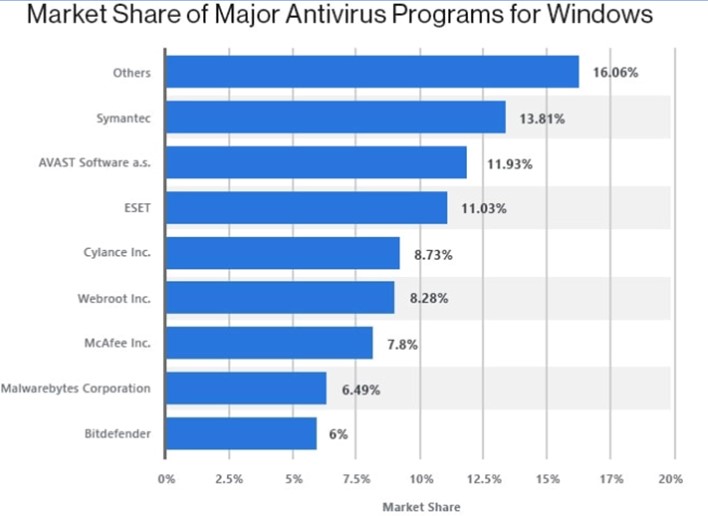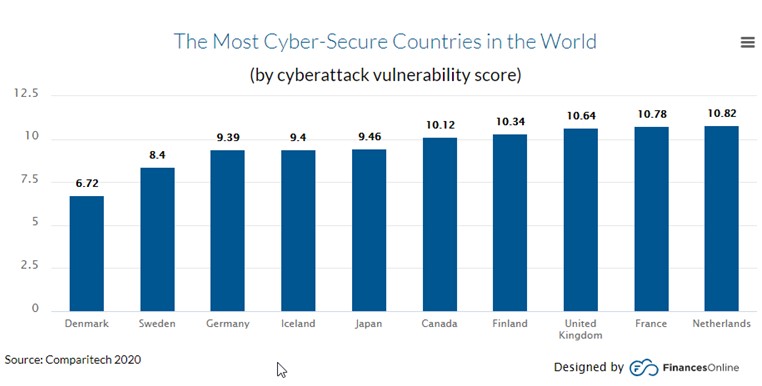No wonder with the increase in the use of electronic devices and internet users, a rise in the number of digital dangers, malware attacks, viruses, spyware, and other threats will be witnessed. Moreover, as the pandemic forced companies to create a remote workforce, connected devices have become more connected than ever.
All this clearly shows, in the next five years, cyber crime will become the biggest threat for everything and every person in the world.
Therefore, the best defense, against evolving unseen cyber attacks, is to adopt smart browsing habits and keep oneself updated. But how can one stay informed?
To learn how to do that let’s read further and know about useful antivirus and cybersecurity statistics, trends and facts

Security Market Forecast
In the last few years, cybersecurity issues like hacking, data breaches are increasing and posing threat to all organizations. This made the cybersecurity market grow and annual revenues reach $42 globally. Moreover, according to Gartner, by 2022, it is expected to reach $170.4 billion.
This has benefited cybersecurity companies like Norton and McAfee as they earned huge profits last year. In addition to this, companies like Trend Micro, AVG, have also shown a noticeable rise in profits. Moreover, free tools like Avast, Microsoft Security Essentials, and a new entrée known as Systweak Antivirus are also making a name as the best antivirus software for Windows.

How Useful are Antivirus Tools?
Luckily, security tools are doing their job just perfectly. They scan the system in real-time and help stay protected against:
- Malware, spyware, and other malicious threats
- Web attacks
- Suspicious emails
- Zero-day threats, PUP, Trojan, and adware
Some noteworthy options are Systweak Antivirus, Norton, McAfee, Bitdefender. They help fight against nasty threats and run in the background without affecting the system’s performance.
Benefits of Using Antivirus Software
If you are looking for the best antivirus software, always look for the following features:
- Malware and Exploit Protection
- Real-time scanning
- USB Protection
- Scanning for Startup Items
- Automatic virus definition updates
- Safe Web Browsing
Cybersecurity The Biggest Risk For Businesses
Already aware of the cybersecurity risk, but looking for numbers to validate the claim?
Here are the alarming cybersecurity statistics:
- By 2021 IT software security vulnerabilities will increase above 25,000
- The global damage to businesses will be over $5 billion.
- The global cybersecurity market is expected to be worth $352.25 billion and is predicted to grow to 14.5% by 2026. (Mordor Intelligence, 2020)
- Losses due to cybercrime damages will reach $6 trillion by 2021. (Cybercrime Magazine, 2020).
- By far the biggest data breach (2020) that involves 10.88 billion is the Cam4 data breach (UpGuard, 2021).
- In 2020, 40% of data breaches came from indirect attacks (Accenture, 2020).
All this explains how online threats put both businesses and customers at stake.
8 Common Reasons for Data Breach
- Weak and Robbed Passwords
- Social Engineering
- Incorrect Configuration and User Error
- Multiple Permissions
- Application Vulnerabilities
- Malware
- BackDoor
- Insider Threats
Cybersecurity Facts and Stats
Most people think an attack is one thing that just won’t happen to them, but they don’t know the chances of experiencing a data breach are higher than they can think. Also, 90% of all cybersecurity breaches are caused by human error.
To understand it better, let’s take a look at Cybersecurity Statistics
- By 2021, every 11 seconds businesses are predicted to experience ransomware attacks.
- More than 350,000 pieces of malware are detected daily.
- Retail, technology, healthcare, and government are popular targets because of personally identified information they have access to
- 64% of companies experience web-based attacks.
- 60% of small business victims of cyber-attack go out of business within six months.
- Since COVID-19, a 300% increase in cybercrimes is reported
- 68% of business leaders feel their cybersecurity risks are increasing. (Accenture)
- On average, only 5% of companies’ folders are properly protected. (Varonis)
- Data breaches exposed 36 billion records in the first half of 2020. (RiskBased)
- 86% of breaches were financially motivated and 10% were motivated by espionage. (Verizon)
- 45% of breaches featured hacking, 17% involved malware and 22% involved phishing. (Verizon)
- The top malicious email attachment types are .doc and .dot which make up 37%, the next highest is .exe at 19.5%. (Symantec)
- $6 trillion is expected to be spent globally on cybersecurity by 2021
- Global ransomware damage costs are said to reach $20 billion by 2021
- Ransomware attacks are estimated to cost $6 trillion annually by 2021.
Cybersecurity Predictions – 2023 and Beyond
- Remote workers will be on cybercriminal’s
- As a side effect of remote working, an increase in the number of cloud breaches will be noticed.
- The cybersecurity skill gap will increase.
- IoT devices will become more vulnerable to cyber attacks as they will reach 75 billion by 2025.
- By 2022, at least 95% of cloud security failures will be caused due to organizations’ faults.

How To Stay Protected From Cyber Attacks
To stay protected against the rising tide of cybersecurity threats, you can implement certain quick steps. This includes:
- Using strong passwords: The most common reason for successful data breaches is weak passwords. Therefore, users must ensure that they use strong passwords. For this, they can take the help of a password manager like TweakPass and create strong random passwords. To know more about the best Password Managers read our post.
- Ensure all installed software is updated: Outdated software poses a greater amount of risk. Hence, keeping software updated to patch all vulnerabilities is required. For this, you can use Systweak Software Updater, an ultimate software updating tool for Windows.
- Avoid visiting unknown URLs: Weblinks are the most common source to spread infections. Avoid clicking on unknown links received in emails.
- Use a VPN: To hide digital footprints using Secure virtual private networks (VPNs) like Systweak VPN is recommended. This will help hide IP addresses and browse the web anonymously. Also, you can access restricted sites and stop hackers from tracking your online activity.
Conclusion
These antivirus and cybersecurity statistics for 2021 explain the risk of ongoing security threats and what can be done to bypass them. We hope you will take this seriously and will implement all necessary measures to stay protected from cyber-attacks.
Remember viruses are not going anywhere, instead of with time they are going to evolve. Therefore, if you don’t want to be a victim of cybercrime, the greatest threat to every company in the world, using the best security solution is suggested.
Sources:
- https://dataprot.net/statistics/antivirus-statistics/
- https://www.varonis.com/blog/cybersecurity-statistics/
- https://www.fundera.com/resources/small-business-cyber-security-statistics
- https://www.cybintsolutions.com/cyber-security-facts-stats
- https://www.business2community.com/cybersecurity/40-terrifying-cybersecurity-statistics-you-need-to-know-for-2021-02384223
- https://financesonline.com/cybersecurity-statistics/
- https://cybersecurityventures.com/hackerpocalypse-cybercrime-report-2016/
- https://www.cyber-observer.com/cyber-news-29-statistics-for-2020-cyber-observer/



 Subscribe Now & Never Miss The Latest Tech Updates!
Subscribe Now & Never Miss The Latest Tech Updates!